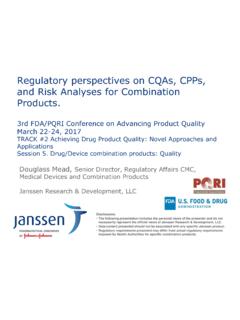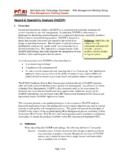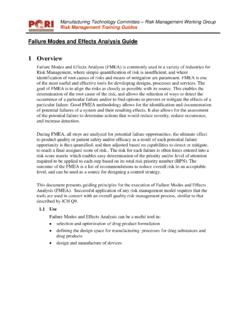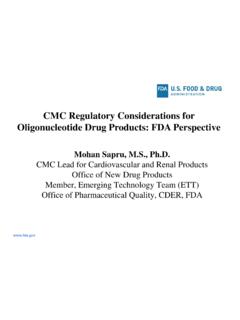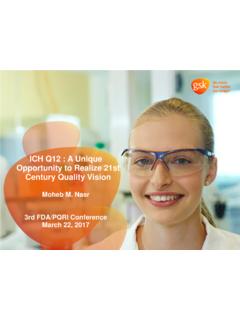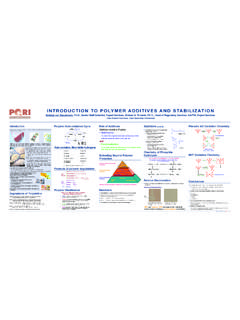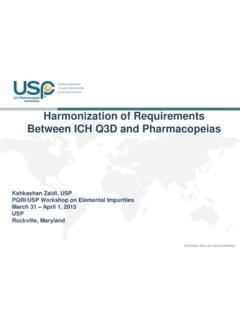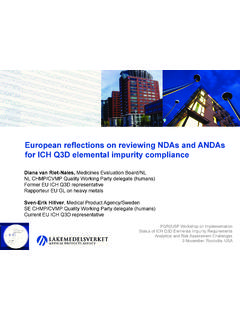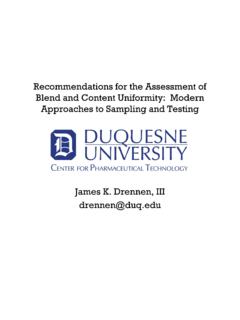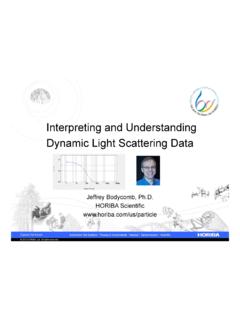Transcription of Nanoparticle Size Analysis: A Survey and Review - PQRI
1 Nanoparticle size analysis : A Survey and ReviewMarc WolfgangVice Chair Nanomedicines AllianceOctober 5, 20152ndFDA/PQRI Conference on Advancing Product QualityTopic: FDA Update on NanotechnologyIntroductionIn 2014 the Nanomedicines Alliance conducted a blinded Survey of its member companies on the topic of particle size analysis . The Survey was followed by an expert panel discussion at the NMA s annual meeting in Washington Mission is to promote and facilitate the scientific advancement, regulatory approval, safe use and public appreciation of nanotechnology-based medicines world-wide for the diagnosis, treatment and prevention of objective of the Alliance is to provide a forum for pharmaceutical, biotechnology and medical device companies with an interest in the development and approval of nanotechnology-based medicines Define priority issues of science, regulation.
2 And policy and work with government partners and other stakeholders to realize the potential of nanomaterials and nanotechnology for medical applicationsProvide government agencies and other stakeholders with practical, science-driven information on nanotechnology as it is used in the development and manufacturing of nanotechnology-based medicines and medical `Purpose and Scope to share information on particle sizing technologies and their use in the characterization and quality control of nanomedicine based Nanoparticle formulations to set the stage for a follow up discussion on the application of particle sizing technologies for product characterization and control with a panel of experts4 Survey Overview`Seven (7) companies participated`Thirteen (13) formulations were presented, representing five (5)
3 Types of Nanoparticle formulations Polymeric nanoparticles 7 Liposomes 2 Micelles 2 Metallic nanoparticles 1 Nano-suspension (API) 1`Six (6) particle sizing technologies employed TechnologyCharacterizationQCDynamic light scattering (DLS)XXDisc centrifugationXElectron microscopy (SEM, TEM, cryo-TEM)XNanoparticle tracking analysis (NTA)XSize exclusion chromatography w/ DLS detectionXStatic light scattering (SLS)XX5 Survey Results`Dynamic light scattering (DLS) most frequently cited/used particle sizing technology Over 85% (6/7) of participating companies use for QC and/or characterization Used for analysis of over 90% (12/13) of Nanoparticle formulations (20 to 1,000 nm) Primary measurements included Zavg (avg particle diameter) and PDI (polydispersity) Multiple instruments/vendors cited`Electron microscopy was the next most frequently cited technology Employed for characterization only Used by ~60% (4/7) of participating companies for characterization of ~60% (8/13) of the Nanoparticle formulations Confirmation of particle size and morphology Sample preparation challenges and incompatibilities cited6 Survey Results`Limited use of two other techniques for QC testing Disc Centrifugation - one company for QC of metallic nanoparticles , mean particle size and polydispersity Static light scattering (SLS)
4 - one company for QC to supplement DLS analysis , mean particle size , polydispersity and fractionation profiling (D90, D50 and D10)`Limited use of three other techniques for characterization testing size exclusion chromatography coupled to DLS detection -two companies to generated size distribution profiles SLS- two companies to generate size distribution profiles Nanoparticle tracking analysis one company to generate particle size and concentration measurements7 Expert Panel Discussion`Purpose and Scope to discuss the strengths, weaknesses and limitations of different particle sizing technologies with a panel of particle measurement experts to discuss the application of particle sizing for control and characterization of nanomedicine formulations8 PanelJeff Clogston, Characterization LaboratorySenior ScientistKevin Mattison.
5 InstrumentsPrincipal Scientist BioanalyticsDariusz Stramski, of California, San DiegoProfessor of Oceanography, Scripps Institution of OceanographyHans van der VoornChief Executive OfficerIzon Science Points Dynamic light scattering `Provides average particle size diameter (Zavg), polydispersity and size distribution10 Key Points Dynamic light scattering `Advantages Ease of use and fast analysis Broad dynamic range, ~ 1 to 1,000 nm High sensitivity and reproducibility for monodisperse, homogenous samples`Limitations Low resolution for polydisperse, heterogeneous samples Requires transformative calculations with assumptions that must be considered when interpreting data particularly with polydisperse samples Assumes spherical shaped particles11 Key Points Dynamic light scattering `Issue with resolution and accuracy of polydisperse, heterogeneous samples Zavg a function of light scattering intensity Intensity increases exponentially w/ particle size .
6 Large particles contribute more to the Zavg than the smaller particles overestimation of average particle size Can detect small number of larger particles in a polydisperse sample, but difficult to detect populations of small particles in polydisperse samples Limitation can be addressed by coupling to a separation technique ( SEC or FFF)12 Key Points Dynamic light scattering `Application Good quality control tool for xmeasuring batch to batch consistencyxchanges overtime (stability)xresolution limitation must be considered for polydisperse samples Excellent diagnosis tool for detecting aggregationxdue to sensitivity to large particlesxpost stress exposure13 Key Points SEC coupled to DLS`Powerful characterization tool if you can get it to work Can be lengthy and difficult Low sample recoveries are common Resins often interact with the nanoparticlesxSEC columns designed for separating soluble proteins not nanoparticles Reproducibility between resin lots can be problematic Often run into flow rate issues14 Key Points Static light scattering `Technique is more applicable to determining molecular weight than particle size `Suffers from same limitation as dynamic light scattering15 Key Points
7 Electron Microscopy`Advantage visual size measurement visual of surface properties works very well with electron dense nanoparticles ( gold)`Limitations labor intensive and time consuming sample prep and staining may affect particle character and produce artifactsxrequired for less electron dense particles doesn t work well with soft , polymer based Nanoparticle cryo TEM often required field of view small, many analyses required to be representative `Application characterization and proof of concept work not a practical QC tool16 Key Points Recent Developments`Tunable Resistive Pulse Sensing (TRPS) Impedance based measurement where voltage is applied across a pore that is filled with electrolyte, resulting in an ionic current.
8 As particles cross the pore they briefly increase electrical resistance, creating a resistive pulse proportional to particle volume. provides particle size , charge, distribution, and concentration measurements17 Key Points Recent Developments` Nanoparticle Tracking analysis (NTA) microscopy-based video tracking of particles under Brownian motion utilizing laser light scattering provides particle size , distribution and concentration measurements18 Key Points TRPS and NTA`Less mature but rapidly developing and improving`Currently a bit more labor and time intensive than DLS, but provide more information`Higher resolution and more suited to analysis of heterogeneous, polydisperse samples`Well suited for characterization `High potential for quality control analysis19 Conclusions`Properties of the Nanoparticle formulation must be considered when selecting a particle sizing technology`DLS appears to be the current industry standard but limitations must be carefully considered for data interpretation (particularly with heterogeneous, polydisperse samples)`EM is a powerful characterization tool, but difficult to use for less electron dense Nanoparticle formulations`New technologies are currently under development and offer promise for improved and more comprehensive particle size analysis20 QUESTIONS21 Marc WolfgangVice Chair, Nanomedicines 551-9620
